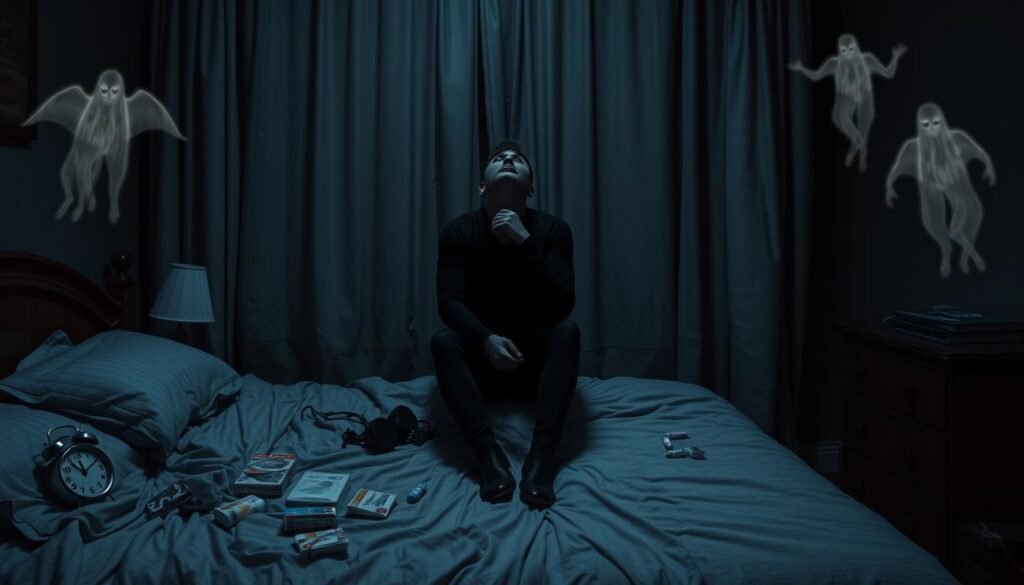As of September 2022, only 37 cases of sporadic fatal insomnia have been identified in the United States. This makes the disorder extremely rare. Sporadic Fatal Insomnia (sFI) is a prion disease. It causes progressive dementia and severe sleep disturbances, leading to serious outcomes. Knowing the early signs is crucial for a better quality of life. Early detection is key in managing this condition.
It’s important to understand the impact of this disorder, despite its rarity. Prion diseases harm brain function, making early action essential. By spotting the early signs, individuals can seek medical advice sooner. This is important in a world where few know about such a rare disease.
Key Takeaways
- Sporadic Fatal Insomnia has only 37 known cases in the U.S. as of 2022.
- This neurological disorder significantly impacts sleep and cognitive functions.
- Recognizing the early symptoms can lead to more effective management.
- Awareness of this condition is crucial given its rarity.
- Prompt medical advice may help to better manage the disorder throughout its progression.
Understanding Sporadic Fatal Insomnia
Sporadic Fatal Insomnia (sFI) is a rare disease that affects brain function. Unlike the genetic form, sFI strikes without warning. It does not require a family history of the disease.
The illness starts when prions in the brain misfold. This happens in the thalamus, crucial for sleep and cognition. Misfolded prions damage the brain, leading to sleep issues, memory loss, and coordination problems. It’s vital to understand sFI, even though it’s rare, affecting 1 in a million yearly.
People usually see symptoms in their 50s. With no cure available, the condition is hard to manage. Yet, researchers are working hard on potential treatments like immunotherapy. They aim to find ways to better the lives of those with sFI.
| Characteristic | Details |
|---|---|
| Nature | Neurodegenerative disease |
| Occurrence | Sporadic, no family history |
| Main Cause | Prion dysfunction in the thalamus |
| Average Age of Onset | 51 years |
| Prevalence | 1 in a million annually |
| Duration of Illness | 8 to 72 months, averaging over 18 months |
| Current Treatments | Immunotherapy (research phase), symptomatic relief through melatonin and vitamin intake |
What Causes Sporadic Fatal Insomnia?
The cause of sporadic fatal insomnia (sFI) is still a mystery. We know it might be due to prion misfolding. This is when abnormal protein structures build up in the brain. People with sFI usually don’t have the genetic changes or usual risk factors seen in other prion diseases.
It’s crucial to understand how this disease works to find treatments. Prion misfolding plays a big role in sFI, leading to worsening brain function. Right now, research is looking into how these prions work and what that means for our health.
Scientists are trying to learn more about prion behaviors to figure out what causes sFI. The complexity of prion diseases makes it hard to find specific causes. But, studying prion misfolding might help us come up with new treatments.
| Characteristic | Sporadic Fatal Insomnia | Familial Fatal Insomnia |
|---|---|---|
| Genetic Mutation | No known mutations | Specific gene mutations present |
| Onset Age | Varies, often later in life | Median onset age 51 years |
| Progression Rate | Varies significantly | Progresses generally within a few years |
| Symptoms | Primarily neurological disturbances | Tremors, impotence, loss of sleep |
Research is ongoing to link prion misfolding with how these diseases show up differently. This could help us better understand sporadic fatal insomnia and similar conditions. For more info on prion diseases, check out this resource.
Recognizing the Early Symptoms of Sporadic Fatal Insomnia
Knowing the early signs of sporadic fatal insomnia is key for quick action. It often starts in small ways, making it important to be alert. People usually have trouble sleeping at first, like weird sleep patterns and messed-up REM cycles. These signs might not get caught during normal check-ups, so it’s important to notice them.
Initial Sleep Disturbances
Early sleep problems are a big warning sign of sporadic fatal insomnia. People might have trouble getting to sleep or wake up a lot. This can mess up someone’s daily life, making them really tired and cranky. If it gets worse, watching out for changes in how you sleep becomes crucial.
Cognitive Changes and Memory Loss
Sporadic fatal insomnia can really affect your thinking and memory. Forgetting things and hard time focusing can show up early on. This usually starts to mess with both work and home life. Catching these signs early helps in talking to doctors and maybe managing the symptoms better. It’s important for those facing this tough disease to get good support and care. To learn more about the early signs of sporadic fatal insomnia click here.
Common Early Signs to Monitor
Spotting the early signs of sporadic fatal insomnia is crucial for prompt diagnosis. Various symptoms provide insights into the illness. By watching for specific changes in behavior, physical conditions, and other signs, people can gauge their health.
Behavioral Changes
Behavioral shifts often come first with sporadic fatal insomnia. These shifts may include:
- Anxiety and changing moods
- Growing irritability or emotional ups and downs
- Clear changes in personality
These changes can deeply affect daily life. It’s important to notice these early signs of the illness.
Physical Symptoms
Physical signs also mark the start of this challenging disease. Common signs include:
- Shakes or uncontrollable movements
- Muscle tightness and lack of coordination
- Problems staying balanced
These physical symptoms can disrupt normal activities. They underscore the importance of getting a medical assessment.
Vision Problems and Hallucinations
As the disease worsens, vision issues can emerge, complicating the diagnosis. Problems can include:
- Seeing double
- Seeing things that aren’t there, which can confuse
Knowing about and watching for these symptoms is key. They show how the disease changes over time.

The Role of Prion Diseases in Sporadic Fatal Insomnia
Prion diseases are a type of neurodegenerative disorder. They are significant in causing sporadic fatal insomnia. These conditions lead to abnormal protein folds, damaging the brain, especially the thalamus. The thalamus is key for sleep and thinking skills.
Learning about prion diseases helps us understand sporadic fatal insomnia better. The illness often starts with trouble sleeping, then leads to thinking problems and severe brain issues. It’s important to spot these early signs quickly.
Scientists are working hard to learn more about prion diseases. They want to find better ways to diagnose and treat them. Some research looks at genetic links to the diseases, like changes in the PRNP gene. For more details, check out this article for info on symptoms and how to handle them.
How Sporadic Fatal Insomnia Compares to Other Neurodegenerative Disorders
Sporadic fatal insomnia is unique among neurodegenerative disorders. It has some overlap with diseases like Creutzfeldt-Jakob and familial fatal insomnia. Still, it differs in how it starts, its symptoms, and how quickly it worsens. Knowing these differences helps us understand sporadic fatal insomnia better.
Differences from Creutzfeldt-Jakob Disease
Sporadic fatal insomnia and Creutzfeldt-Jakob disease belong to the prion disease family. Yet, how they appear in patients is quite different. People with sporadic fatal insomnia mainly have trouble sleeping and other nervous system issues. On the other hand, Creutzfeldt-Jakob disease starts with significant memory and behavior problems. About 18.9% of those with Creutzfeldt-Jakob disease don’t show these cognitive signs. This fact highlights how different sporadic fatal insomnia is.
Familial Fatal Insomnia vs. Sporadic Fatal Insomnia
Both familial and sporadic fatal insomnia can shrink the thalamus and disturb sleep. However, familial fatal insomnia is inherited. This is contrary to sporadic fatal insomnia, which doesn’t typically run in families. Familial fatal insomnia progresses through clear stages. Sporadic fatal insomnia, however, gets worse more unpredictably. The timeline for sporadic fatal insomnia ranges from 13 to 73 months. This variance shows it has a wider range of outcomes compared to familial fatal insomnia.
| Feature | Sporadic Fatal Insomnia | Creutzfeldt-Jakob Disease | Familial Fatal Insomnia |
|---|---|---|---|
| Genetic Basis | No known PrP gene mutation | Can involve genetic mutations | Hereditary PrP gene mutation |
| Age of Onset | 30-74 years | Median age around 60 years | Varies, often younger than sFI |
| Duration of Illness | 13-73 months | Shortest duration around 5 months | Longer, variable based on stage |
| Predominant Symptoms | Sleep disturbances, autonomic dysfunction | Cognitive/behavioral changes | Severe sleep disorders and hallucinations |

Importance of Early Diagnosis
Spotting sporadic fatal insomnia (sFI) early is key to managing it well. It’s vital because its symptoms are similar to Alzheimer’s and Parkinson’s disease. This makes it tough for doctors to tell them apart.
Challenges in Identifying the Disease
Diagnosing sporadic fatal insomnia is tough due to a few reasons. One main reason is its rarity, with only 24 cases known by 2016. This means doctors don’t often encounter it. They use tests like polysomnography (PSG), genetic analysis, and nuclear imaging. But, these can sometimes not give clear answers.
Prion diseases like sFI show symptoms such as muscle twitching, sleep troubles, and fast dementia. These can look like other neurological issues, making correct diagnosis hard. Plus, sFI doesn’t have the genetic markers that familial fatal insomnia does. This adds to the challenge for doctors.
Yet, there’s hope with ongoing research for quicker diagnosis methods. Support networks, like the Creutzfeldt-Jakob Disease Foundation, give crucial help to affected families. They stress the importance of noticing early symptoms quickly.
Treatment Options and Support Management
Sporadic fatal insomnia has no cure, but treatment focuses on supportive care. This aims at managing symptoms to keep the patient’s life quality as high as possible. It’s important to make them comfortable as the disease progresses.
Medications such as sedatives and drugs for seizures are common treatments. They help with sleep problems and encourage rest. For example, temazepam might be used for a short time, with doses of 15-30 mg at bedtime. Another option is eszopiclone, starting at 1 mg for those who have trouble staying asleep, and may increase to 2-3 mg.
Making lifestyle changes is also key. Families are advised to ensure a healthy diet, use vitamins and adjust drugs if needed. Getting psychological support can also ease the emotional burden of the disease.
Research is ongoing to find new treatments, like monoclonal antibodies being tested in trials. This research could bring new hope for managing this condition in the future.

| Treatment Option | Purpose | Notes |
|---|---|---|
| Sedatives (e.g., Temazepam) | Improves sleep quality | Short-term use recommended |
| Eszopiclone | Helps with sleep maintenance | Starting dose of 1 mg |
| Antiseizure Medications | Management of neurological symptoms | Adjustments may be necessary |
| Therapeutic Interventions | Emotional and psychological support | Coping strategies provided |
| Monoclonal Antibodies | Investigational treatment | Currently undergoing clinical trials |
Preventative Measures and Future Outlook
There are no sure ways to prevent sporadic fatal insomnia yet. But knowing about the disease can help lower risks. Ongoing future research focuses on understanding it better. This could lead to improved care for affected people. Being part of clinical studies is important. It helps both the participants and expands our knowledge about these diseases.
The future of sporadic fatal insomnia is still unknown as studies go on. Knowing more about prion diseases helps catch them earlier. This is a big change from when diagnosis mainly happened after death. Better diagnostic tools now allow for quicker responses. This can greatly improve how patients fare.
Here is a comparison of the current understanding of sporadic fatal insomnia and related prion diseases:
| Aspect | Sporadic Fatal Insomnia | Creutzfeldt-Jakob Disease | Fatal Familial Insomnia |
|---|---|---|---|
| Incidence | Very rare, case reports only | 1-2 cases per 1 million inhabitants | Familial; very few cases globally |
| Genetic Component | No known genetics | Sporadic by nature | Autosomal dominant inheritance |
| Progression | Rapid deterioration | Variable; can progress quickly | Early onset varies |
| Current Research | Focus on diagnosis and definition | Investigation into genetic factors | Linked to specific mutations |
Understanding sporadic fatal insomnia is key for future research. It brings hope for treatments and better handling of the disease. Recognizing the role of genetics and environment is crucial. It calls for more scientific investigation in this field.
Conclusion
Sporadic fatal insomnia is a rare yet severe brain disorder. Early symptom recognition is key. It helps with prompt treatment, improving patient chances.
Initial signs include mental health issues and losing cognitive functions. Knowing these early can help doctors and patients alike.
Advances in tests and treatments are ongoing. Awareness is crucial for early detection. This leads to better care and hopeful treatments.
The fight against prion diseases like this is advancing. Global awareness can help discover better prevention and treatment methods. Ongoing research and education will help future patients live better lives.